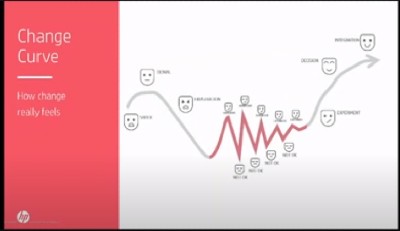
The X-Factor of 'Change'
Employee Engagement#EmployeeExperience#PMEXIN
Change happens every day and it's critical for business growth. It’s ongoing, all around us, and it’s only getting faster across organizations. For the continued success of organizations, it’s critical for leaders to accelerate the desired business outcomes and drive applied engagement. This necessitates managing "change" the right way. So, how do you design change strategies that will drive business results? Designing change, building a change experience program to delivering it, and being able to capture lessons learned and moving people positively through change with minimum disruption to the business is complex, says Amanda Hume, Head of Change, HP.
When it comes to transformational changes, it’s always complicated because it features multiple changes across multiple audiences with different impacts and different timelines, Amanda adds. Change management is no rocket science and it’s about people skills and commonsense. In times of great change, commonsense goes often goes out of the window, and the efforts around connecting and communicating with employees as we move through change unfortunately decrease and, in some cases, disappear.

“We have a decade-long experience of leading and delivering change at HP and this is what has influenced how we designed, built, and delivered change at HP,” she adds. Talking about the deployment of HP’s HR system with over three hundred thousand employees across 67 countries, 11 different languages, and all in one deployment day, Amanda says, "we have learned what works best and we have built best practices around them.” The company has also changed its approach to "change" from their learning moments in terms of what does not work. From their experiments with change, the company grew its strategies so that it can accelerate desired business outcomes.
Things have changed over the years, and today we have change all around us and each individual change initiative follows its own path and a defined outcome. Change looks complex because many of us get to experience multiple things at the same time, says Amanda, adding that “each employee’s change journey (not all of them are work-related) is unique and different because of the environment we live in.”
Referring to Kubler-Ross' "change curve", which shows how people move through change and the emotional journey individuals typically experience, Amanda says, “I am not very sure whether it truly shows what happens when we go through change”. Amanda shares HP's version of how change really feels. The journey is not radically different from Kubler-Ross, but their change curve has a zig-zag motion that’s the actual reality, according to Amanda. Leading through change is not a smooth journey; it has ups and downs, she adds.

The X-Factor of change
Talking about employee experience, Amanda talks about the X-Factor of change, which is about asking the question “what will our employees say?” that defines the core of what employee experience is. This question changed their approach to how they design and deliver change programs. “When we think of the success of the change initiative program, typically we do it through the lens of program team –-we closed the deal on time or we went live with the system or we implemented the new policy, etc. But that does not always indicate success. It’s not enough to think about the success only by the program matrix. What is key to success is driven by “employees”. The X-factor is when you start by thinking about the employee experience. “There is more to change than just reaching the destination. The change journey starts before we get to our destination and often continues beyond our destination,” Amanda argues. Mapping the journey should be through the eyes of your employees. If requires, you need to go for reverse engineering to get the experience right.
To sum up, for all your change initiatives, ask the question – “what will our employees say?” Think about what you want your employees to say about their experience of the steps of the journey, concludes Amanda.













